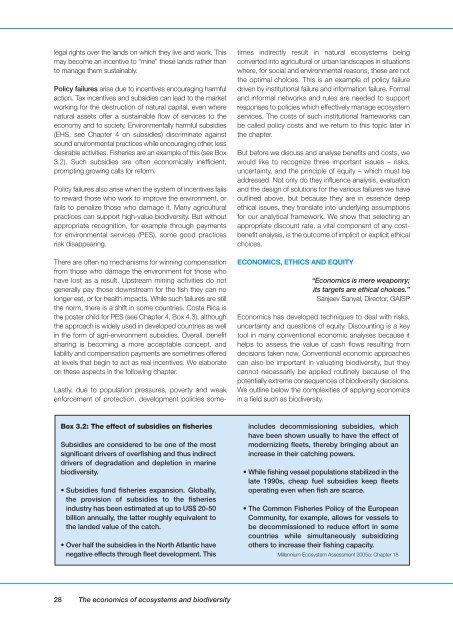Interim Report - TEEB
Interim Report - TEEB
Interim Report - TEEB
You also want an ePaper? Increase the reach of your titles
YUMPU automatically turns print PDFs into web optimized ePapers that Google loves.
legal rights over the lands on which they live and work. This<br />
may become an incentive to “mine” these lands rather than<br />
to manage them sustainably.<br />
Policy failures arise due to incentives encouraging harmful<br />
action. Tax incentives and subsidies can lead to the market<br />
working for the destruction of natural capital, even where<br />
natural assets offer a sustainable flow of services to the<br />
economy and to society. Environmentally harmful subsidies<br />
(EHS, see Chapter 4 on subsidies) discriminate against<br />
sound environmental practices while encouraging other, less<br />
desirable activities. Fisheries are an example of this (see Box<br />
3.2). Such subsidies are often economically inefficient,<br />
prompting growing calls for reform.<br />
Policy failures also arise when the system of incentives fails<br />
to reward those who work to improve the environment, or<br />
fails to penalize those who damage it. Many agricultural<br />
practices can support high-value biodiversity. But without<br />
appropriate recognition, for example through payments<br />
for environmental services (PES), some good practices<br />
risk disappearing.<br />
There are often no mechanisms for winning compensation<br />
from those who damage the environment for those who<br />
have lost as a result. Upstream mining activities do not<br />
generally pay those downstream for the fish they can no<br />
longer eat, or for health impacts. While such failures are still<br />
the norm, there is a shift in some countries. Costa Rica is<br />
the poster child for PES (see Chapter 4, Box 4.3), although<br />
the approach is widely used in developed countries as well<br />
in the form of agri-environment subsidies. Overall, benefit<br />
sharing is becoming a more acceptable concept, and<br />
liability and compensation payments are sometimes offered<br />
at levels that begin to act as real incentives. We elaborate<br />
on these aspects in the following chapter.<br />
Lastly, due to population pressures, poverty and weak<br />
enforcement of protection, development policies sometimes<br />
indirectly result in natural ecosystems being<br />
converted into agricultural or urban landscapes in situations<br />
where, for social and environmental reasons, these are not<br />
the optimal choices. This is an example of policy failure<br />
driven by institutional failure and information failure. Formal<br />
and informal networks and rules are needed to support<br />
responses to policies which effectively manage ecosystem<br />
services. The costs of such institutional frameworks can<br />
be called policy costs and we return to this topic later in<br />
the chapter.<br />
But before we discuss and analyse benefits and costs, we<br />
would like to recognize three important issues – risks,<br />
uncertainty, and the principle of equity – which must be<br />
addressed. Not only do they influence analysis, evaluation<br />
and the design of solutions for the various failures we have<br />
outlined above, but because they are in essence deep<br />
ethical issues, they translate into underlying assumptions<br />
for our analytical framework. We show that selecting an<br />
appropriate discount rate, a vital component of any costbenefit<br />
analysis, is the outcome of implicit or explicit ethical<br />
choices.<br />
ECONOMICS, ETHICS AND EQUITY<br />
“Economics is mere weaponry;<br />
its targets are ethical choices.”<br />
Sanjeev Sanyal, Director, GAISP<br />
Economics has developed techniques to deal with risks,<br />
uncertainty and questions of equity. Discounting is a key<br />
tool in many conventional economic analyses because it<br />
helps to assess the value of cash flows resulting from<br />
decisions taken now. Conventional economic approaches<br />
can also be important in valuating biodiversity, but they<br />
cannot necessarily be applied routinely because of the<br />
potentially extreme consequences of biodiversity decisions.<br />
We outline below the complexities of applying economics<br />
in a field such as biodiversity.<br />
Box 3.2: The effect of subsidies on fisheries<br />
Subsidies are considered to be one of the most<br />
significant drivers of overfishing and thus indirect<br />
drivers of degradation and depletion in marine<br />
biodiversity.<br />
• Subsidies fund fisheries expansion. Globally,<br />
the provision of subsidies to the fisheries<br />
industry has been estimated at up to US$ 20-50<br />
billion annually, the latter roughly equivalent to<br />
the landed value of the catch.<br />
• Over half the subsidies in the North Atlantic have<br />
negative effects through fleet development. This<br />
includes decommissioning subsidies, which<br />
have been shown usually to have the effect of<br />
modernizing fleets, thereby bringing about an<br />
increase in their catching powers.<br />
• While fishing vessel populations stabilized in the<br />
late 1990s, cheap fuel subsidies keep fleets<br />
operating even when fish are scarce.<br />
• The Common Fisheries Policy of the European<br />
Community, for example, allows for vessels to<br />
be decommissioned to reduce effort in some<br />
countries while simultaneously subsidizing<br />
others to increase their fishing capacity.<br />
Millennium Ecosystem Assessment 2005a: Chapter 18<br />
28 The economics of ecosystems and biodiversity

















